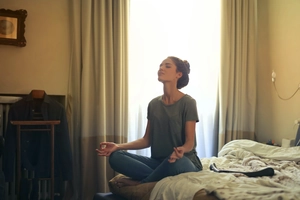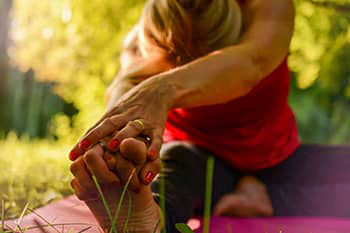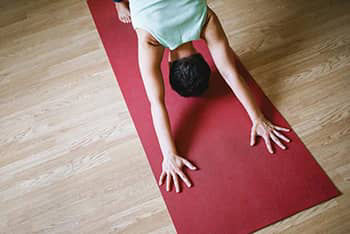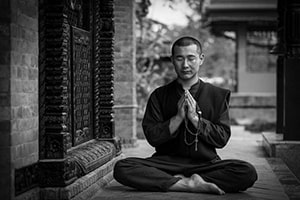
How to start a Yoga practice at home

Starting a home practice is easier then you think. All you need a quite space with plenty of room, a mat and a good understanding of about twenty Asanas or poses. The first two steps are easy, but do not feel overwhelmed about learning enough poses.
This will take some time to learn, but using this site, you are given very detailed descriptions with any precautions needed. After sometime of daily practice, you will notice that you can get into and out of the poses easier, but more importantly, you notice how much better you feel and that you are less stressed and aggravated.
With enough time, you will be able to move through life experiencing less negative emotions while being able to better deal with life's issues.
This practice at it's essence, is a practice for the mind, body and soul. At the center we see the practice of Yoga as a practice of many practices, from Shatkarma or six cleanses, Asanas or Yoga Poses, Hasta Mudras or hand gestures, Bandhas or body locks, Mudras or body gestures, Pranayama or breathing exercises, Dhyana or Meditation, all of these practices of Yoga have great benefits to offer us: physically, mentally and spiritually.
This practice at its core is spiritual in nature and we urge you to practice as such.
A complete practice should include Shatkarma, Asana, Pranayama, Mudra and Dhyana or Meditation, with Hasta Mudra being preformed during a practice if you wish.
Hasta Mudra are not a practice of Hatha Yoga and is seen as it's own practice, but can be preformed during most practices.
While practicing you can recite a Mantra, bring your awareness to a certain Chakra that is associated with the Asana being preformed, properly breathing, meaning allowing the belly to expand during the inhale and bringing the belly button to the spine.

The intention of the practitioner is a big factor in weather the practice will be a spiritual practice or a physical practice.
For this practice to be spiritual, the practitioner needs to leave the material world at the door. There is no reason to bring the worries, wants and concerns of life's issues into the practice. Letting go of of those issues allows us to move from the material world into the spiritual world.
There are over twenty techniques of Yoga, at the Karma Kriya Center we focus on Hatha Yoga. With this technique, after the Shatkarmas have been preformed, an Asana sequence is practiced, then Pranayama, Bandha and the practice is ended with a Meditation.
Hatha Yoga sees the Asanas as the least important practice to preform, with that said this article discusses this practice in depth because these poses need to be preform in a certain way.
Breathing through the nose
The breath is vital for life as it provides oxygen and Prana to the body but how we breath is important. When we inhale through the nose we can take in a full breath allowing the lungs to completely inflate, the air is filtered by the hairs in our nose and the two main Nadis are stimulated.
Breathing through the nose is known to lower the blood pressure and reduce stress, but during exercising or preforming strenuous activities, breathing through the nose requires less effort and is known to lower the systolic blood pressure. Therefore as we practice, breathing through the nose is an important factor in a Yoga practice.
How to practice Yoga Asana
When starting a Asana sequence, you can start with the Standing Asanas, Sitting Asanas or Reclining Asanas. We suggest starting with the Standing Asanas, then practicing your way through the different groups of Asanas, finishing the sequence with the Reclining Asanas so you can finish with Shavasana.
In Yoga, the practice of Asanas or Yoga poses is also known as Yoga Asana. Theses poses range from easy to advanced, but no matter where you are currently at, these poses should be practiced with great care and understanding.
This practice is preformed along with the breath, when this happens improper breathing habits can be corrected, the lung capacity improves, relaxation comes into the mind and body and moving into and out of a pose becomes easier.
The breath controls the heart rate and activity of the mind. When the breath is short and eradicate, which is typically caused by taking in a shallow upper chest breath, the heart rate raises and tension is brought into the body negativity effecting the activity of the mind.

When practicing, if the knee comes to the chest or the chest comes to the knee, then the right side is preformed first, this is because of the ascending colon, transverse colon and descending colon.
When we start with the right side, we are stimulating the nerves of the colon to release it's contents and if we start with the left side then we make ourselves constipated.
This is also true with twisting poses. Twisting pose are great for the spine because they make it supple, but they also help to detox the body. This is because when we twist the torso, the organs are being twisted, this action is equal to wringing out a wet rag, forcing toxins from the organs into the elimination system of the body.
During standing balancing poses, it is best to find a focal point about three to five feet in front of you, this will help you keep your balance. Inhale lifting the toes, spreading them as wide as possible and exhaling them down to the mat.
This helps you get the maximum amount of the foot on the mat to help you keep your balance as well as help to release any tension. During practice if the tongue is pressed against the back of the teeth or the toes are curled, tension is brought into the body.
A focal point is use in other balancing poses but the focal point will be placed differently depending on the pose.
Anytime we preform a back bending pose, a forward fold pose should be preformed before or after. This is because both types of poses properly aligned the vertebra as well as tones the muscles and nerves of the back.
If a lot of forward folding and back bending poses are preformed, then twisting pose should be preformed, this is because twisting to torso tones the muscles of the back and stimulates the nerves of the spine.
Shavasana
In Sanskrit, Shavasana translates to corps pose. With this pose, the legs are separated slightly wider then the shoulders, the arms are about thirty degrees from the sides of the body, with the palms facing up. The eyes are closed, allowing the body to completely relax and the body to melt into the mat.
This practice allows the breath and heart rate to return to normal, while allowing the benefits of the Asana sequence to incorporate into the mind, body and soul.
Modern science has shown us that during day time when we learn or experience something, that knowledge or experience is set into the mind and or body when we sleep.
This is because when we sleep, we are totally relaxed allowing this process to happen. This happens due to deep relaxation which can be experienced with Shavasana if the practitioner allows the mind and body to completely relax without falling asleep.
As the practice continues
After laying in Shavasana for three to five minutes, start to wiggle the fingers and toes. Next rotate the wrist and ankles, inhale the knees up while keeping the feet on the mat, exhale the knees to the chest wrapping the arms around the knees giving yourself a big hug. Start to rock from right to left, this rocking motion helps to stimulate the nerves of the back and bring fresh blood supply to the back.
After rocking side to side for several times completely roll over to the right side allow the hips to stack one on top of the other. Using the right arm as a pillow and placing the lift hand on the mat in front of yourself. When you are ready while inhaling lift the body in a sitting position.
Pranayama
Also known as breathing exercises, is preformed with the back straight but not ridged with the chin in a neutral position. Any Meditative Asana or comfortable seat should be used. During the practice, if possible you can also preform most any Hasta Mudra.
You may find it more comfortable to use a folded blanket, Yoga block, Meditation cushion or Pranayama cushion. When the hips are raised above the knees, this takes stress off the knees allowing for longer periods of sitting.
During the practice, it is best to relax as much as possible while enveloping yourself into the practice. You can start with three to five minutes of practice, gradually increasing the duration over time.
Before starting any practice, please refer to the precautions section of the page first.
Meditation
This practice is the last and highest practice of Yoga and is the easiest and hardest practice. This is because Meditation is easy but the ego makes it hard. The mind may want to wonder which makes focusing and relaxing difficult.
Do not be discouraged at all. Just like anything else we do in life, the more we practice the better we get. If you need, start with five to ten minutes while sitting with intent and determination. Keep bring your awareness to the practice at hand.
We also encourage you to sit every day, when this is done the practice will become easier, flower before you and allow you to receive all the benefits possible.
Remember that you reap what you sow. With enough time this daily practice will get easier and enjoyable.
After sometime, you can bring this practice into your every day life. Allowing the mind to be at ease, being happier, feeling free and healthier.

Related Articles